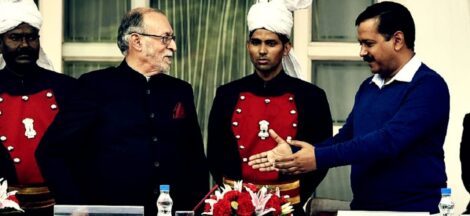By Subrata Majumder
Dichotomy looms on the bounce back in GDP growth in 2018-19 and its impact on job creation. Critics are puzzled that while the upturn was on account of growth in manufacturing, it has not made any proportional impact in terms of job creation.
During the first quarter of 2018-19, GDP growth rose to 8.2 percent, against just 5.6 per percent in the corresponding period last year. The manufacturing sector witnessed the highest growth of 13.5 percent, against a drop of 1.8 percent in the corresponding period last year. But, the growth failed to deliver the green shoots for job creation.
Opposition parties have held the NDA government responsible for mishandling the economy and blamed it for causing damage to the manufacturing sector, which faced major headwinds due to demonetization. They also alleged that the informal sector (self–employment, casual and contract workers), which accounts for 80 percent employment, was badly hit by demonetization.
Domestic investors shied away from making investment in the informal sector and instead used the banking channel to convert their black money into white through fraudulent means. It is believed that such black money generally get into the informal sector. Since nearly all the demonetized currencies returned to the banks, as reported by the RBI, the informal sector became starved of funds, which would have led to the creation of more jobs.
In contrast, foreign investment sustained a high growth trajectory, despite demonetization, which showed confidence in India’s growth potential in the world market. Foreign investment surged to $ 43 billion in 2016-17 and rose to $ 44 billion in 2017-18. Multilateral institutions like IMF and World Bank and leading rating agencies like Morgan Stanley and Moody’s were upbeat on India’s growth prospects. They considered demonetization as a temporary hick-up. The IMF’s World Economic Outlook envisaged a strong recovery in the Indian economy and pitched for a 7.3 percent growth in 2018-19. Moody’s was even more upbeat, forecasting a growth of 7.5 percent in 2018-19.
BSE Sensex, which is vulnerable to any economic and political upheaval, showed strong resilience to demonetization woes. BSE Sensex of 30 companies increased to 29,620 points in 2016-17, up from 25, 341 points in 2015-16 and further to 32,968 points in 2017-18, defying the setbacks of demonetization.
Why couldn’t then job creation keep pace with the GDP and manufacturing growth? Manufacturing is the backbone of Make in India and there has been a major shift in the sector during the past three years with focus on technology oriented production and digitization taking precedence over labour intensive to capital and skilled labour intensive industries.
According to NITI Aayog, organized sector preferred to stay away from investment in labour-intensive or informal industries and opted for capital or skilled labour intensive industries. This resulted in manufacturing growth in such industries, which meant that jobs were created more for skilled labour while the informal sector was in total disarray due to demonetisation, thus severely impacting job growth in the sector.
The development of electronic industry is a case in point. It is both capital and labour intensive industry. There was a boom in the manufacturing of mobile phones and industrial electronics. Manufacturing of mobile phones made a fourfold jump and industrial electronics increased by over 58 percent during the three year period of 2014-15 to 2016-17. Production of mobile phones increased from Rs. 189 billion in 2014-15 to Rs. 940 billion in 2016-17 and of industrial electronics increased from Rs. 393 billion to Rs. 622 billion during the same period.
According to estimates, every job created in manufacturing has multiple effect of 2-3 percent additional jobs in other sectors. Despite having large working force base (62 percent of the population and more than 54 percent of the population below 25 years of age) and low cost workforce advantage, India’s job prospects have been eroded due to its low availability of skilled manpower. According to estimates, only 4.7 percent of working force in India is formally skilled, against 24 percent in China – a stiff competitor to cheap labour availability. The low availability of skilled workforce has become a deterrent to job aspirants, even though new jobs were created due to transition in manufacturing activities
Another reason for the lackluster growth in job creation is that even though India has been globally integrated, it has not leveraged its manufacturing opportunities through GVC (Global Value Chain) value added production network across the borders. Opportunities surfaced with the transition in manufacturing in developed countries, combining their high tech know how with lower wage labour in developing countries. India’s growing engagement in FTAs and CEPAs with its neighbours should have been propitious to these opportunities. South East and East Asia are major stakeholders in this new pattern of GVC production network.
India has an edge over South East and East Asia countries. With the rise in wages in China, Thailand, Malaysia and Indonesia – the main partners for GVC production network – India stands to gain full partners in this transition of manufacturing network, provided the country produces more skilled workers and improves its logistic infrastructures. India’s logistic costs are much higher than developed as well as emerging nations. India’s logistic costs are estimated to be around 14-15 percent of GDP, almost double of the 7-8 percent in developed countries.
In the light of the new pattern of manufacturing activity, it is pertinent that India should enhance its pool of skilled labour and improve logistic infrastructure for widening the opportunities for job creation. (IPA Service)
The post Why GDP Growth Failed To Create More Jobs appeared first on Newspack by India Press Agency.


